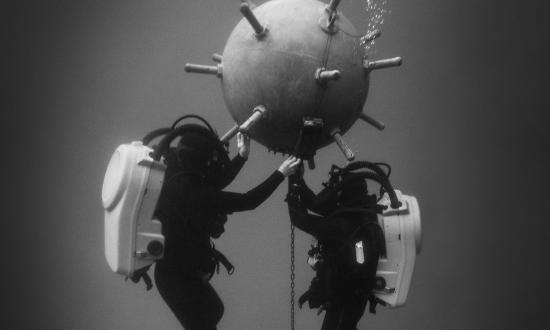Captain James A. Metcalfe, U.S. Navy Reserve (Retired)
In World War II, Yeoman Cecil S. King served on three ships that were sunk shortly after he left them. He ascribed his good luck to an old sailor superstition that you won’t drown if you have a pig tattooed on one foot and a rooster on the other—which he did!
Captain Bruce H. Charnov , U.S. Navy Reserve (Retired)
The coffee mess became a Navy tradition when President Woodrow Wilson’s teetotaling Secretary of the Navy Josephus Daniels issued General Order No. 99 banning alcohol on ships. Popular myth ascribes the origin of the phrase “cup-of-Joe” to this event.
Lieutenant (junior grade) Brennan Suffern, U.S. Coast Guard
The superstitions associated with whistling are interesting and strange. Sailors whistle to communicate ship-to-ship movements or alert the crew through the boatswain’s whistle. At the same time, a sailor whistling to himself appears to taunt the wind to conjure a storm. Or call a mutiny.
Stuart Klearman, U.S. Navy Veteran
The crossing-the-line ceremony, held when a ship crosses the equator. It demonstrates the perverse, sadomasochistic, debauched, maniacal, hedonistic, tortuous, and idolatrous nature of sailors. Who in their right mind would endure such a thing for the title of Shellback and a paper certificate?
Commander Earl Higgins, U.S. Navy (Retired)
Flying the Jack flag at the bow when moored and the national flag at the stern. This custom is apparently quite old and observed by many nations. Both flags are struck when the ship gets underway, and the national flag is hoisted at the mainmast.
Theodore Kuhlmeier, U.S. Marine Corps Veteran
Ship names are associated with many superstitions. Some, such as Wasp, carry an aura of bad luck that can transfer to a modern vessel. Three Wasps met bad endings—a Revolutionary War ship, a War of 1812 ship, and a World War II aircraft carrier. Changing the name of a commissioned ship also brings bad luck. Let us hope this is untrue for the USS Robert Smalls (CG-62), which until March 2023 was the USS Chancellorsville (CG-62).
Lieutenant Commander Bob Fliegel, U.S. Navy (Retired)
Splice the mainbrace is one of many customs inherited from the Royal Navy. When I dined with then–Prince Charles in Nassau in 1973 on the occasion of Bahamian independence, he remarked (I paraphrase), “If you’d allow your sailors a pint at sea, perhaps we wouldn’t see so many drunk American sailors ashore.” I replied, “Sir, I believe I’ve seen just as many drunk Royal Navy sailors ashore.”
Mary Jorgenson
Referring to ships with female pronouns is strange. Even remarkable ships named for men still get referred to with female pronouns. I find it a little odd to refer to vessels such as the Edmund Fitzgerald and Carl D. Bradley as she/her.
Senior Chief Paul H. Sayles, U.S. Navy (Retired)
My dad had pig and rooster tattoos. He said that they were considered good luck, as the two animals were said not to sink when in water. As he served in submarines for many years, the superstition might have been rather academic.
Commander John M. McGrail, U.S. Navy (Retired)
The seagoing community has several interesting maritime superstitions regarding toasting. For one, do not toast with water because doing so condemns the toaster to a watery grave. Sailors also do not clink glasses when toasting because the ringing glass tolls the death of a sailor.
Michael Ravnitzky, Life Member
The Navy’s 21-gun salute signifies respect and disarmed readiness, rooted in earlier 7-gun and 3-gun traditions. The United States adopted the international 21-gun standard in 1875, previously established as the Presidential Salute in 1842. Once a display of transnational dominance, it now honors national flags, presidents, international dignitaries, and state funerals.
Chief Petty Officer John M. Duffy, U.S. Navy (Retired)
The seven weeks of hazing and instruction—as well as the actual day—leading to the pinning ceremony at my chief petty officer initiation. A close second would be the crossing-the-line ceremony to initiate all the slimy Pollywogs into trusty Shellbacks.
Lieutenant Commander Jason Lancaster, U.S. Navy
Taco Tuesday, Burger Wednesday, Pizza and Wings Saturday. Without the continuity in themed-meal days, at sea I would never know what day it was! During my best and hardest tour, by supper time I had forgotten I had a burger at lunch.
Captain Daryk Zirkle, U.S. Navy
The expression “turning a blind eye” is believed to come from the siege of Copenhagen (1801), in which Admiral Horatio Nelson, second in command of the English fleet, was ordered to withdraw but pretended not to see the flagship's signals to do so by putting his glass to the eye that had been blinded in an earlier battle. Our judgment is not only expected, but required, to be applied. But we must be right. Weighing the rightness of an order is the most perilous thing we can do.
Jerry Whaley, U.S. Navy Veteran
When I was serving from 1959 to 1967, whistling on board the USS Saratoga (CV-60) was frowned on. It was calling the ghosts of the past to return to the ship. Another was the oxymoron of calling work details a party.
Petty Officer Casey Orndorf, U.S. Navy
I have always wondered why older sailors find such mirth in asking “boots” to do impossible things like collecting 10 feet of chow line, going to the engine room for a “BT punch,” or worse, scaring a young lookout into reporting that B1 Romeo Delta (bird) before the commanding officer shoves his boot . . .
Rear Admiral K. J. Norton, U.S. Navy (Retired)
The crossing-the-line ceremony when a ship crosses the Equator and Shellbacks (sailors who had crossed previously) spend a day “inducting” Pollywogs (sailors who had not crossed) into the “mysteries of the deep.” It is essentially sanctioned hazing (but fun nonetheless).
Commander Matt Hahne, U.S. Navy (Retired)
Tracked the pig-on-foot tattoo as far as I can to South Pacific sailing days. Pigs were cherished in the sailing days: they ate little, could always be eaten, and are inherently buoyant! For my family, it is cheap insurance against drowning!







